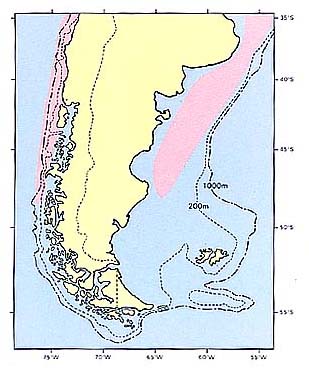タカノハダイ科
- HOME
- デジタル図鑑
- パタゴニア海域の重要水族
- 硬骨魚綱 スズキ目
- タカノハダイ科
タカノハダイ科(Cheilodactylidae)

87 ブレカ(Bureka)
Cheilodactylus bergi Norman, 1937
Papamoscus, Castañeta, Besugo blanco (Arg.); Breca (Ch.)
フエダイ(業界名)
特 徴:
背鰭16~18棘,24~28軟条,臀鰭3棘,12~15軟条,胸鰭14~15軟条,腹鰭1棘,5軟条,鰓耙数4~7+1+14~16=20~23,側線鱗数53~63,鰓条骨数7,脊椎骨数11~12+23~24=34~36。頭長は体長の27.8~29.7%,眼径は6.1~7.0,体高は34.5~49.5%,体幅は12.3~15.8%,吻長は11.2~13.3%,両眼間隔は6.8~8.8%,上顎長は7.5~12.9%,尾柄高は7.1~8.8%,胸鰭長は39.3~45.8%,腹鰭長は18.1~20.9%,第1背鰭高は11.7~15.6%,第2背鰭高は6.9~9.4%,臀鰭高は8.9~10.5%。体高は高いが,かなり変異がある。口は小さく唇は厚く,上顎後縁は眼の前縁にはるかに届かないが,伸出可能。両顎に絨毛状の細歯がある。体側鱗は大きい円鱗で,背鰭と臀鰭の基底には鱗鞘がある。吻部を除く頭部背面と鰓蓋部に細鱗が密に分布する。側線は体側中央部より背部よりを背縁に沿ってゆるやかに湾曲しながら尾鰭基底部まで走る。背鰭棘は強大。胸鰭は大きく,とくに第10軟条は非常に長く臀鰭起部をやや越える。腹鰭も大きく,胸鰭起部のやや後方に始まる。尾鰭は深く二叉する。体背部は褐色,体側物と腹部は銀白色。背鰭起部前方から胸鰭起部上方にかけて淡い黒色帯がある。背鰭,臀鰭,尾鰭は暗色。胸鰭は黄色味を帯びる。腹鰭は銀白色。主鰓蓋骨上縁上方に肩帯の張り出しが著しい。体長40cmに達する。白身で肉質は良い。
分 布:
アルゼンチンからチリにかけての南アメリカ大陸南部の陸棚上に分布。
備 考:
アルゼンチンにおける1977年~1982年の年間漁獲量は2,766t,2,575t,1,858t,1,506t,2,700t,1,348t(FAO, 1984)で,フライなどとして賞味される。年令と全長の関係は11.7cm(1年),18.9cm(2年),23.5cm(3年),27.4cm(4年),30.3cm(5年),33.7cm(6年),35.5cm(7年),39.5cm(8年)と成長は遅い(Bellisio, López and Torno, 1979)。
(中村 泉)
Material examined:
10 from Argentina (154.2-254.3 mm SL), 10 from Chile (249.0-394.8 mm SL), FAKU 42801, 42810, 43452, 43457, 43458, 43462, 43465, 43467, 43473, 43474; CP 54, 296, 297, 282, 283, 399, 490, 848-850.
Description:
D ⅩⅠ-ⅩⅢ, 24-28; A Ⅲ, 12-15; P1 14-15; P2 Ⅰ, 5; GR 4-7+1+14-16=20-23; BR 7; LLS 55-63; V 11-12+23-24=34-36. HL 27.8-29.7% of SL; ED 6.1-7.0; BD 34.5-49.5; BW 12.3-15.8; SN 11.2-13.3; IO 6.8-8.8; UJ 7.5-12.9; CP 7.1-8.8; P1L 39.3-45.8; P2L 18.1-20.9; D1H 11.7-15.6; D2H 6.9-9.4; AH 8.9-10.5.
Body deep, extremely compressed, body depth 2.6-3.0 times in SL. Head large, about 3.5 times in SL. Snout long, about twice as eye diameter. Eye moderate, 5 times in head. Mouth small, slightly protractile with well developed fleshy lips on both jaws. Posterior end of upper jaw extending below anterior nostril, never reaching anterior margin of eye. Villiform teeth bands on both jaws. Gill-rakers short. Pseudobranchiae present. Nostrils situated nearer to anterior margin of eye than to tip of snout, anterior nostril round without flap. Interorbital region slightly round, its width about 1.3 times in snout. Small cycloid scales on head except snout and both jaws. Scales on body, large cycloid and not easily deciduous. Scaly sheath developed in bases of dorsal and anal fins. Dorsal fin spines long and extremely strong. Three strong and tough anal fin spines, with second spine longest. Pelvic fin well developed, its tip nearly reaching anus. Pectoral fin large, with elongate 10th fin ray. Caudal fin deeply forked. Lateral line gently curved, running parallel to dorsal profile from posttemporal region to caudal fin base.
Distribution:
Off Brazil to Argentine Patagonia in the Atlantic, and Chile in the Pacific.
Remarks:
Bahamonde and Pequeño (1975) recognized Cheiloductylus bicornis (Steindachner) and Cheiloductylus variegatus Valenciennes, and did not recognize Cheiloductylus bergi in Chile.
(Izumi NAKAMURA)

Distribution of Cheilodactylus bergi in Patagonia.

Lateral line scale (left) and scale below lateral line (right).
- 1